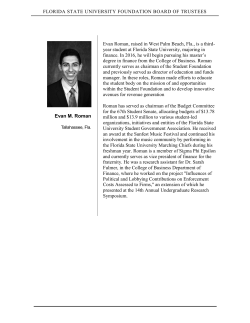
WATER FOR ROMAN CITIES
Römisch-Germanisches Museum of Cologne Roncalliplatz 4, 50667 Köln Opening times: Daily except Monday 10 a.m. - 5 p.m. First Thursday in the month 10 a.m. - 10 p.m. Tel. 0221 221 24438 or 24590 E-mail: rgm@stadt-koeln.de Activities accompanying the exhibition: August 20, 2015, 6.30 p.m. in the Römisch-Germanisches Museum, Cologne, Illustrated lecture by Prof. Dr. Klaus Grewe, Bonn: Water for Roman Cities − new information on the planning and routing of Roman aqueducts. In German language, admission free. Bus excursion to the Roman aqueduct in the Eifel with a short walk along the Roman Aqueduct hiking trail between Grünen Pütz near Nettersheim and Kall-Urft. Lunch (self paying) July 18, 2015, 9 a.m. Meeting point in Hürth-Hermülheim, Kiebitzweg (tram stop - line 18, parking area). Return about 6 p.m. Fee to cover costs 25 Euros. Information and registration under www.kreaforum.de Not suitable for wheelchairs. Bus excursion to the Roman Dover-Berg Tunnel near Düren and the medieval Tiergarten Tunnel at Blankenheim. Picnic lunch (bring own) August 8, 2015, 9 a.m. Meeting point in Hürth-Hermülheim, Kiebitzweg (tram stop - line 18, parking area). Return about 6 p.m. Fee to cover costs 25 Euros. Information and registration under www.kreaforum.de Not suitable for wheelchairs. Cologne City walking tour Visit six Romanesque churches, in particular to see objects carved out of ’aqueduct marble‘. Lunch (self paying) September 19, 2015, 10 a.m. to 6 p.m. Meeting point in front of St Severin‘s Church Fee to cover costs 32 Euros. Information and registration under www.kreaforum.de Not suitable for wheelchairs. Underground stone channel, through which 20 million litres of drinking water flowed into Roman Cologne each day. In the exposed section of the channel near MechernichBreitenbenden, the imprint of the centring planks are still visible. Photograph K. Grewe ------------------------------------------------Middle left Partially reconstructed bridges of the Eifel aqueduct near Mechernich-Vussem. Photograph K. Grewe Roman aqueducts on the Appian Way near Rome Illustration: T. Wehrmann for Geo Epoche after a painting by Zeno Diemer (1914) in the Deutsches Museum in Munich ------------------------------------------------Middle right ------------------------------------------------Bottom A Museum of WATER FOR ROMAN CITIES JUNE 26 TO OCTOBER 11, 2015 The availability of hygienic, perfectly clean water for drinking and other purposes was absolutely essential in Roman times. Large cities could only develop at locations with a secure supply of spring water. The construction and maintenance of aqueducts, which often carried fresh water over great distances, were therefore among the most important responsibilities of Roman magistrates and emperors. Gravity conduits are known, as are high-pressure pipes that were constructed on the principle of communicating vessels, and − an exceptional technical accomplishment − the large aqueduct bridges. The extraordinary achievements of Roman engineers in the construction of aqueducts are on display in this exhibition. A precise survey of the terrain, detailed planning, and skilled construction with the simplest of technical equipment, such as the ‚Chorobat‘ (similar to a modern spirit level) and the ‚Groma‘ (a surveying instrument), produced brilliantly built tunnels and aqueduct bridges with sometimes colossal arches. They are evidence of both Rome‘s selfconfidence and her claim to power. voirs and sedimentation basins along the Eifel aqueduct have been made accessible to the public as an archaeological hiking trail. Since the water from the River Urft is extremely hard, calcareous sinter was deposited on the bottom and sides of the conduits − in some sections as much as 40 cm thick. Medieval stonemasons methodically quarried these calcareous deposits and used the ‚aqueduct marble‘ to decorate churches, monasteries and castles. The material was also widely traded − columns, altar tables and tombstones made of this unusual material can be found in the cathedrals along the Hellweg (a medieval travellers‘ route) as well as in the cathedrals at Roskilde in Denmark, in Canterbury and in some Dutch churches. The exhibition gives an insight into the technology of aqueduct construction in the Roman Empire. The Eifel aqueduct is taken as an example to explain numerous technical details. Particular attention is paid to the reuse of the construction in the Middle Ages. The Eifel aqueduct, which brought fresh water from springs in the limestone region of the Eifel Mountains to Roman Cologne, was one of the longest Roman aqueducts. Here, for the first time, is archaeological proof of how such a construction project was broken down into individual sections. A massive stilling basin formed the junction between two sections of the conduit. Water-capture points, bridges, reserThe Roman Eifel aqueduct near Euskirchen-Kreuzweingarten. The calcareous deposits here are up to 30 cm thick. Photograph K. Grewe Measurement of heights with the aid of a ‚Chorobates‘. This early form of spirit level was made of a wooden beam 20 ft (approx. 6 m) long on vertical supporting legs. It was adjusted horizontally by means of plumb lines and a groove containing water. Illustration F. Spangenberg (Illu-Atelier) ------------------------------------------------- ------------------------------------------------Top left Top right Pont du Gard, a multi-story Roman aqueduct bridge in southern France. The water was carried in a closed channel on top of the rows of arches. Photograph K. Grewe Relief on the Ammianos sarcophagus from Hierapolis in Phrygia (Pamukkale, Turkey) with depiction of a water-driven dual saw to cut stone. Photograph K. Grewe Publication accompanying the exhibition: K. Grewe, Aquädukte. Wasser für Roms Städte (Rheinbach 2014), available in the museum shop and in bookshops (ISBN 9783-95540-127-6); € 29.95 Functional layout of the Castellum divisorium at Nimes (France). Illustration T. Wehrmann for Geo Epoche ------------------------------------------------Middle ------------------------------------------------Bottom ------------------------------------------------Accompanying publication ------------------------------------------------Title page
© Copyright 2025









